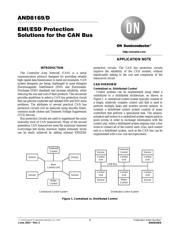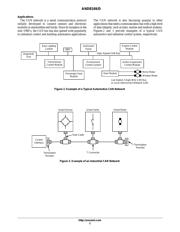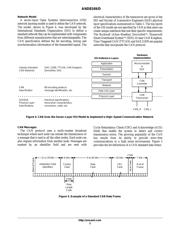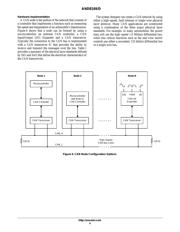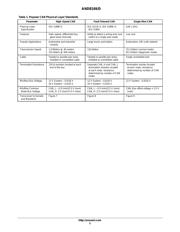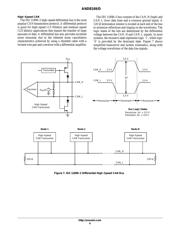herunterladen

© Semiconductor Components Industries, LLC, 2014
June, 2014 − Rev. 2
1 Publication Order Number:
AND8169/D
AND8169/D
EMI/ESD Protection
Solutions for the CAN Bus
INTRODUCTION
The Controller Area Network (CAN) is a serial
communication protocol designed for providing reliable
high−speed data transmission in harsh environments. CAN
system designers are being challenged to meet stringent
Electromagnetic Interference (EMI) and Electrostatic
Discharge (ESD) standards and increase reliability, while
reducing the size and cost of their products. This document
provides guidelines to select a CAN bus protection circuit
that can prevent conducted and radiated EMI and ESD noise
problems. The attributes of several practical CAN bus
protection circuits will be analyzed using discrete filters,
common mode chokes and Transient Voltage Suppression
(TVS) devices.
Bus protection circuits are used to supplement the noise
immunity level of CAN transceivers. Many of the second
generation CAN transceivers meet the minimum transient
overvoltage test levels; however, higher immunity levels
can be easily achieved by adding external EMI/ESD
protection circuits. The CAN bus protection circuits
improve the reliability of the CAN module, without
significantly adding to the cost and complexity of the
transceiver circuit.
CAN OVERVIEW
Centralized vs. Distributed Control
Control systems can be implemented using either a
centralized or a distributed architecture, as shown in
Figure 1. A centralized control system typically consists of
a single, relatively complex control unit that is used to
perform multiple tasks and monitor several sensors. In
contrast, a distributed control system consists of many
controllers that perform a specialized task. The sensors,
actuators and motors in a centralized system require point to
point wiring in order to exchange information with the
control unit, while a distributed system requires only a few
wires to connect all of the control units. Also, each control
unit in a distributed system, such as the CAN bus can be
implemented with a low cost microprocessor.
Main
Control Unit
Solenoid
Control
Motor
Control
Sensor
Sensor
Sensor
Sensor
Solenoid
Control
Control
Unit
Control
Unit
Motor
Control
Sensor
Control
Unit
Sensor
Control
Unit
Sensor
Control
Unit
Sensor
Control
Unit
CAN Bus
Centralized Control System Distributed Control System
Figure 1. Centralized vs. Distributed Control
APPLICATION NOTE
http://onsemi.com
Verzeichnis
- ・ Paket-Footprint-Pad-Layout on Seite 10
- ・ Teilenummerierungssystem on Seite 15
- ・ Markierungsinformationen on Seite 15
- ・ Blockdiagramm on Seite 5
- ・ Typisches Anwendungsschaltbild on Seite 8
- ・ Technische Daten on Seite 3 Seite 9
- ・ Anwendungsbereich on Seite 2 Seite 5 Seite 14
- ・ Elektrische Spezifikation on Seite 3

